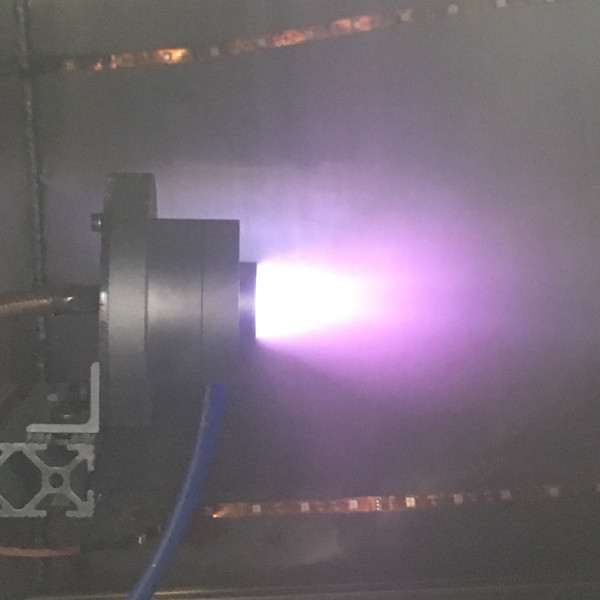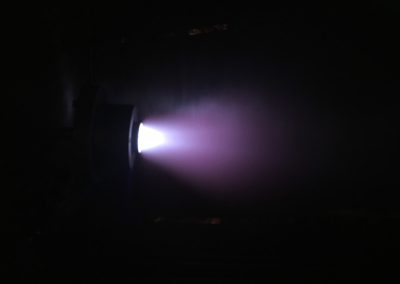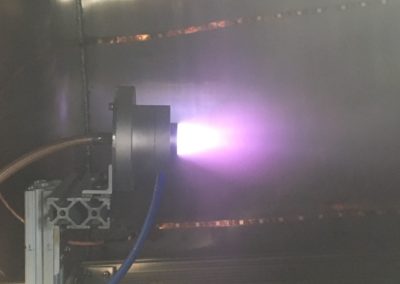Project
Electron Cyclotron Resonance Thrusters
project personnel
Benjamin Wachs, Sal Baldinucci
principal investigator
Benjamin Jorns
project sponsors
NASA
associated facilities
ECR Thruster Chamber
Electron Cyclotron Resonance (ECR) is one of several methods for ionizing and heating a plasma using electromagnetic (EM) waves. In a typical EM wave driven thruster, gas is ionized and heated by an EM wave, and this plasma is then ejected from the source through a magnetic nozzle, producing thrust. Wave driven thrusters have the potential to eliminate plasma contacting electrodes, which are subject to erosion and failure in typical electrostatic thruster designs. Furthermore, this type of thruster topology can substantially simplify overall thruster design, with only a single power supply necessary for operation.
However, to date, electromagnetic wave driven thrusters have not been able to match the performance and efficiency of traditional electric propulsion devices such as hall effect thrusters and ion thrusters. Most EM driven thrusters have utilized inductively coupled or helicon wave heating, which has produced efficiencies typically under 10%. Recent studies have shown that ECR heating has the potential to greatly improve these numbers, however, the physics is not well understood.
The goal of this project is to investigate ECR heating in magnetic nozzles, and to develop scaling laws for these thrusters. In particular, this research aims to determine if this type of thruster is viable for low power (sub kW) propulsion systems, which are increasingly important in new satellite designs. A prototype ECR thruster based on previous experiments has been constructed and tested at PEPL. Future work will focus on understanding and improving device efficiency through changes in wave coupling, thruster geometry, and applied power.
Selected Publications
Observation of Low Frequency Plasma Oscillations in the Plume of a Partially Magnetized Magnetic Nozzle
Hepner, S.T., Wachs, B.N., Collard, T.A., and Jorns, B.A.
Effect of Background Pressure on Ion Dynamics in an Electron Cyclotron Resonance Thruster
Wachs, B. and Jorns, B.
Technique for Two-Frequency Optimization of an ECR Magnetic Nozzle Thruster
Wachs, B., and Jorns, B.
Background pressure effects on ion dynamics in a low-power magnetic nozzle thruster
Benjamin Wachs, Benjamin Jorns
Wave-Driven Non-Classical Electron Transport in a Low Temperature Magnetically Expanding Plasma
Hepner, Shadrach; Wachs, Benjamin; Jorns, Benjamin
The role of low frequency drift waves in driving non-classical transport in magnetic nozzles
Shadrach T. Hepner and Benjamin Jorns
Anomalous electron thermal conductivity in a magnetic nozzle
Shadrach Hepner and Benjamin A. Jorns
Optimization of an ECR thruster using single, two-frequency, and pulsed waveforms
Benjamin N. Wachs and Benjamin A. Jorns
Impact of Facility Electrical Boundary Conditions on the Performance of an Electron Cyclotron Resonance Magnetic Nozzle Thruster
Salvatore S. Baldinucci, Sophia Bergmann, Jack A. Hondagneu, Benjamin Wachs, and Benjamin A. Jorns
Sub-Millinewton Thrust Stand and Wireless Power Coupler for Microwave Powered Small Satellite Thrusters
Benjamin N. Wachs and Benjamin A. Jorns



